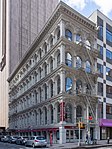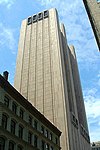Anthony Street Theatre
1812 establishments in New York (state)Buildings and structures demolished in 1821Demolished theatres in New York CityFormer theatres in ManhattanTheatres completed in 1812

The Anthony Street Theatre was an early New York City theatre which operated intermittently from 1812 to 1821. It opened as the Olympic Theatre in May 1812 and had multiple names during its brief existence.
Excerpt from the Wikipedia article Anthony Street Theatre (License: CC BY-SA 3.0, Authors, Images).Anthony Street Theatre
Broadway, New York Manhattan
Geographical coordinates (GPS) Address Nearby Places Show on map
Geographical coordinates (GPS)
| Latitude | Longitude |
|---|---|
| N 40.717 ° | E -74.005 ° |
Address
Broadway 339
10013 New York, Manhattan
New York, United States
Open on Google Maps






